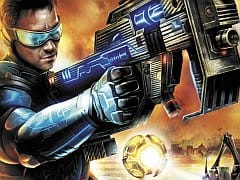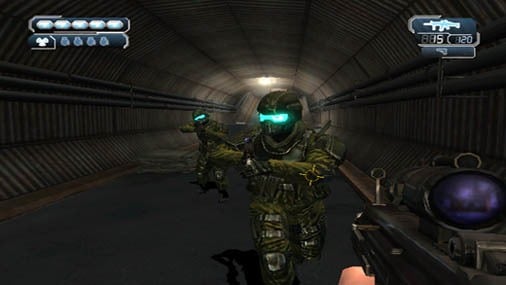You can trust VideoGamer. Our team of gaming experts spend hours testing and reviewing the latest games, to ensure you're reading the most comprehensive guide possible. Rest assured, all imagery and advice is unique and original. Check out how we test and review games here
When you talk the talk you have to walk the walk or face a lot of egg on your face. Developer High Voltage Software more or less built up Wii exclusive FPS The Conduit to be not only the best shooter the console has seen, but also a game that could compete with the best on other platforms. They’d set themselves up for a massive fall, but we’d hoped it wouldn’t happen. The Wii is in need of more quality shooters (Metroid Prime comes to mind, but it’s not really a pure shooter series), and The Conduit appeared to be the best shot we had. It seems walking the walk is harder than High Voltage imagined, at least when it comes to creating a single-player experience.
It’s hard to ignore the noise the developer made about the game’s visuals. More than any other aspect of the game, it’s the next-gen style effects that have received the most attention. It’s really quite disappointing then, that The Conduit’s presentation is such a mixed bag. At times it can look quite impressive and certainly up with the best we’ve seen on the Wii (although never really doing anything breathtaking), but at others it’s mediocre PS2 quality at best. The enemy designs are uninspired and the environments even worse. The tech behind the game might be extremely solid, but when you’re shooting aliens in bland hallways and dull streets it’s hard to get excited.
Those wanting a gripping storyline are out of luck too, with the plot on offer in The Conduit often bordering on the kind of quality you’d find in a budget children’s sci-fi show. Washington D.C. has been invaded by an alien race known as the Drudge. These aliens spawn into the city through glowing orange portals and the task of stopping them has been placed on your shoulders. A government group called the Trust becomes involved and then things go very X-Files, with conspiracy theories cropping up all over the place. Things aren’t helped by some truly terrible loading screen conversations, in which the voice acting is some of the worst we’ve heard for quite some time.
After working through the short single-player campaign (which will take an average gamer no more than a long afternoon to complete) it’s easy to see why such a focus pre-release was on the visuals: the core game just isn’t that good. There’s a decent mix of human and alien weapons, but the actual missions, and objectives within them, seem dated beyond belief. At no point did something truly interesting happen that would have given the game an identity of more than “that Wii game with fancy graphical effects”.
The Drudge come at you in various shapes and sizes, and with differing attack strategies. Some act like normal human soldiers, others roll towards you and then explode, and some hatch from pod-like devices before charging at you in packs. Thanks to an impressive control scheme you’ll never have too much trouble taking them down (the Wii Remote aiming works well and there’s lock-on should you need it), but there are a few terribly designed sections that raise the difficulty level to near breaking point.
High Voltage really has delivered one of the best FPS control schemes we’ve used on the Wii, which makes the rather by the numbers campaign all the more disappointing. It’s an incredibly customisable game too, with everything from the aiming and camera panning options to the layout of the HUD being changeable. We did have a few issues with the default settings, though: moving the Wii remote forwards to melee attack feels hit and miss and the ‘-‘ button as both reload and pick up weapon caused a few unwanted weapon changes. Grenade throwing mapped to a thrust forward with the Nunchuck feels awkward at first, but soon becomes second nature, and works far better than the Wii Remote melee.
If you’ve been following The Conduit you’ll know that you get to use a device known as the All Seeing Eye (ASE). This piece of Drudge technology is used to change the phase state of certain items, making them invisible to humans. In your hands you’re able to bring the phase of these items in-line with our world and interact with them. It all sounds quite cool, but in terms of gameplay you just end up scanning certain things, opening doors and blowing up mines that are otherwise invisible to human eyes.
While the single-player campaign is mediocre at best, The Conduit’s multiplayer component is altogether more entertaining. The whole thing still feels a little dated due to the fact that you need to add friends specifically to this game (although that’s a problem in all Wii games), but a Wii game having an online mode this feature-rich is practically unheard of. There are solo, team and objective-based game modes for up to twelve players, and a ranking system based on XP earned through your performances. The objective modes aren’t exactly revolutionary, all built around capturing the opposing team’s ASE device, but get some friends together {you’ll need to play with friends in order to chat online using the Wii Speak peripheral) and there’s good fun to be had. Lag varied from game to game, but in our experience games with over 10 players tended to see people warping across the map.
For all the developer’s boasts, The Conduit is nothing more than an occasionally attractive run of the mill FPS, backed up by a decent multiplayer mode that stands out due to the relative weakness the Wii has in this area. Wii owners looking for a pure FPS will likely plough through the campaign and spend enough time with the multiplayer to make their purchase worthwhile, but anyone who games across all major platforms will wonder why anyone made a fuss about The Conduit in the first place.

/https://oimg.videogamer.com/images/c778/the_conduit_43.jpg)






